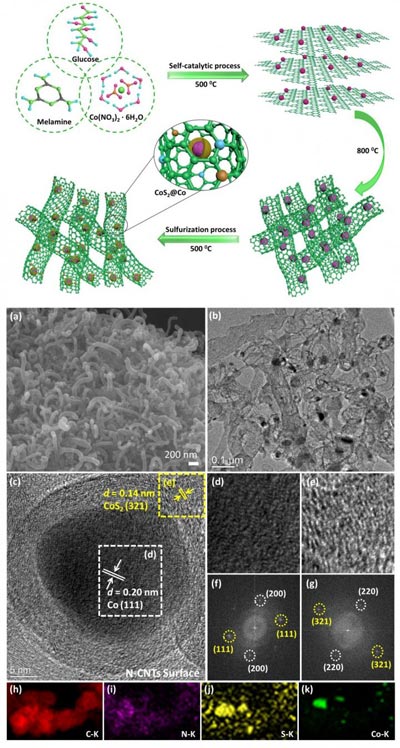S, N co-doped carbon nanotube-encapsulated CoS2@Co

Schematic illustration and physical characterization of S, N co-doped carbon nanotubes encapsulated core-shell (CoS2@Co) nanoparticles. Credit: ©Science China Press
Electrochemical water splitting is favorable strategy to produce high-purity H2. The current mainstream catalysts for water electrolysis are precious metals (Pt, RuO2, IrO2), which possess superior catalytic activity, relatively low over-potential and favorable catalytic kinetics, but their high cost and poor cycle stability is still unaffordable.
Therefore, it is urgent to develop a new type of hydrogen production catalyst with low cost, high catalytic activity and high stability.
Due to its low cost, high abundance, and good electrical conductivity, the transition metal-Co and its derivatives have shown great promise in electrocatalysis.
However, stability has been a big issue due to their high chemical activities. To address this issue, encapsulation of Co nanoparticles into carbon shell has been proposed as an effective strategy to inherit the high electrocatalytic activity of the transition metal, and further prevent its corrosion from the harsh electrolytic environment.
By tuning the metal composition and structure of carbon layers, the catalytic properties of these composites can be regulated.
Recently, Liu Zhao-Qing's group of Guangzhou University reports a bifunctional catalyst, transition metal cobalt ions induced the self-growth of nitrogen doped carbon nanotubes, which are further vulcanized to incorporate sulfur into the carbon nanotubes framework.
The obtained materials (S, N-CNTs/CoS2@Co) exhibit excellent HER and OER performance. As cathode and anode, S, N-CNTs/CoS2@Co can rapidly dissociate water molecules to produce hydrogen and oxygen gases, requiring only 1.633 V to reach a current density of 10 mA cm-2, and a strong stability under various operating currents is also observed.
###
See the article:
Jing-Yu Wang, Ting Ouyang, Nan Li, Tianyi Ma, Zhao-Qing Liu. S, N co-doped carbon nanotube-encapsulated core-shelled CoS2@Co nanoparticles: efficient and stable bifunctional catalysts for overall water splitting, Science Bulletin, 2018, DOI: 10.1016/j.scib.2018.07.008.
https:/
Media Contact
More Information:
http://dx.doi.org/10.1016/j.scib.2018.07.008All latest news from the category: Life Sciences and Chemistry
Articles and reports from the Life Sciences and chemistry area deal with applied and basic research into modern biology, chemistry and human medicine.
Valuable information can be found on a range of life sciences fields including bacteriology, biochemistry, bionics, bioinformatics, biophysics, biotechnology, genetics, geobotany, human biology, marine biology, microbiology, molecular biology, cellular biology, zoology, bioinorganic chemistry, microchemistry and environmental chemistry.
Newest articles

NASA: Mystery of life’s handedness deepens
The mystery of why life uses molecules with specific orientations has deepened with a NASA-funded discovery that RNA — a key molecule thought to have potentially held the instructions for…

What are the effects of historic lithium mining on water quality?
Study reveals low levels of common contaminants but high levels of other elements in waters associated with an abandoned lithium mine. Lithium ore and mining waste from a historic lithium…

Quantum-inspired design boosts efficiency of heat-to-electricity conversion
Rice engineers take unconventional route to improving thermophotovoltaic systems. Researchers at Rice University have found a new way to improve a key element of thermophotovoltaic (TPV) systems, which convert heat…



